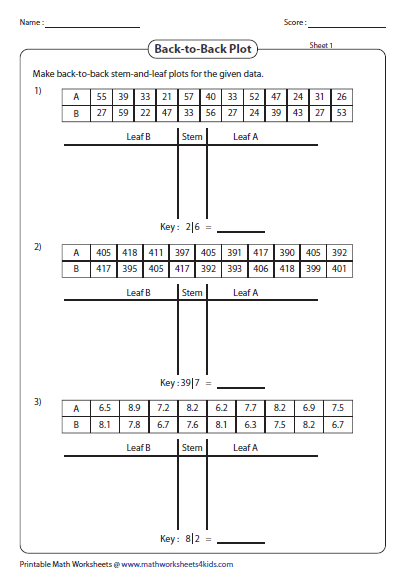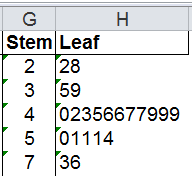

For example, the minimum and maximum values for this tutorial are 14 and 57.

Manually enter the stems based on the minimum and maximum values.

Navigate to where you wish to display your values and type in the heading ‘Stem’ in one cell and ‘Leaf’ in the adjacent cell.Now that we have gotten the minimum and the maximum values, we can proceed to create our stem and leaf plot as follows: Step Three: Create the Stem and Leaf plot. In the cell adjoining the Maximum, enter the Maximum function by typing “=MAX” and then open parenthesis and select the range of values you want to determine maximum value from and then close parenthesis and hit on the enter key in your keyboard.Select the range of values you want to determine minimum value from and close parenthesis then click on the Enter key on your keyboard. In the cell adjoining the Minimum, enter the Minimum function by typing “=MIN” and opening parenthesis.Type Minimum and Maximum in separate Cells (In our example this is Cell C2 and C3 respectively).The minimum and maximum values allow you to determine the range of your stem Step Two: Determine the minimum and maximum value of your dataset. In this tutorial, we will be using the set of data below: The table below shows the Ages of 20 participants from a research study. This data may be a precise number (e.g., 34) or a distribution range (e.g., 10 – 19) such as age group, test scores, etc. To create a stem and leaf plot, you must enter the data you wish to work with. To create a layout that looks like the above, the steps listed below should be followed. The objective of this tutorial is to create a layout that looks like this: Ages of an older group of women in a sports team.Temperature chart of a city over some time.Test scores for High school students of a class.The following are examples of other types of data sets where a stem and leaf plot may be applied. It works best for smaller sets of data because the plot displays the exact value of every data point within the dataset.įor example, if you are involved in a research study where you gathered the age details of about 140 participants, you may want to consider using a stem and leaf plot to chart for that data. It is best used when you have a data set not greater than 150 data points. Stem and leaf plots work best with quantitative data, especially smaller sets of data. Types of data that are used with stem and leaf plots The stem usually represents the first digit of a data point, while the leaf represents the last digit.įor example, if a stem digit is eight and the leaf digit is four, the data point is 84.

Hiw to make stem plot series#
Stem and Leaf plots are very useful because they allow us to see the distributions across different categories of data without the use of complex mathematical computations.Ī stem and leaf plot displays a series of scores in a simple and comprehensible way. It is usually numbered 0-9 depending on the range of the dataset you are working with.


 0 kommentar(er)
0 kommentar(er)
